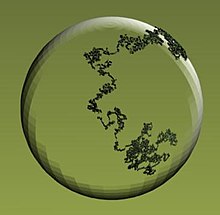Proses stokastik
Dalam teori kebarangkalian dan bidang yang berkaitan, satu proses stokastik (/stoʊˈkæstɪk/) atau proses rawak ialah objek matematik biasanya ditakrifkan sebagai keluarga daripada pemboleh ubah rawak. Proses stokastik digunakan secara meluas sebagai model matematik untuk sistem dan fenomena yang kelihatan berbeza-beza secara rawak. Contohnya termasuk pertumbuhan populasi bakteria, arus elektrik turun naik disebabkan oleh bunyi haba, atau pergerakan molekul gas.[1][4][5] Proses stokastik mempunyai aplikasi dalam banyak bidang seperti biologi,[6] kimia,[7] ekologi,[8] neurosains,[9] fizik,[10] pemprosesan imej, pemprosesan isyarat,[11] teori kawalan,[12] teori maklumat,[13] sains komputer,[14] kriptografi[15] dan telekomunikasi.[16] Tambahan pula, perubahan yang kelihatan rawak dalam pasaran kewangan telah mendorong penggunaan meluas proses stokastik dalam kewangan.[17][18][19]

Secara matematik, ia bermaksud sistem yang mana wujud pemboleh ubah rawak X (t) yang bersandar masa. Jika x1, x2, dsb adalah ukuran X (t) pada masa t1, t2, dst, maka sistem ini diperihalkan sepenuhnya oleh ketumpatan kebarangkalian bersama p (x1, t1; x2, t2; ...).
Di dalam kes di mana kebarangkalian mengukur x adalah bebas daripada nilai sebelumnya, dan bebas daripada masa, kita ada "cubaan Bernoull", di mana hukum kebarangkalian untuk x yang sama pakai. Satu lagi jenis proses stokastik ialah "proses Markov" di mana kebarangkalian tersebut hanya bergantung kepada keadaan x sebelumnya.
Rujukan sunting
- ^ a b Joseph L. Doob (1990). Stochastic processes. Wiley. m/s. 46, 47.
- ^ L. C. G. Rogers; David Williams (2000). Diffusions, Markov Processes, and Martingales: Volume 1, Foundations. Cambridge University Press. m/s. 1. ISBN 978-1-107-71749-7.
- ^ J. Michael Steele (2012). Stochastic Calculus and Financial Applications. Springer Science & Business Media. m/s. 29. ISBN 978-1-4684-9305-4.
- ^ Emanuel Parzen (2015). Stochastic Processes. Courier Dover Publications. m/s. 7, 8. ISBN 978-0-486-79688-8.
- ^ Iosif Ilyich Gikhman; Anatoly Vladimirovich Skorokhod (1969). Introduction to the Theory of Random Processes. Courier Corporation. m/s. 1. ISBN 978-0-486-69387-3.
- ^ Paul C. Bressloff (2014). Stochastic Processes in Cell Biology. Springer. ISBN 978-3-319-08488-6.
- ^ N.G. Van Kampen (2011). Stochastic Processes in Physics and Chemistry. Elsevier. ISBN 978-0-08-047536-3.
- ^ Russell Lande; Steinar Engen; Bernt-Erik Sæther (2003). Stochastic Population Dynamics in Ecology and Conservation. Oxford University Press. ISBN 978-0-19-852525-7.
- ^ Carlo Laing; Gabriel J Lord (2010). Stochastic Methods in Neuroscience. OUP Oxford. ISBN 978-0-19-923507-0.
- ^ Wolfgang Paul; Jörg Baschnagel (2013). Stochastic Processes: From Physics to Finance. Springer Science & Business Media. ISBN 978-3-319-00327-6.
- ^ Edward R. Dougherty (1999). Random processes for image and signal processing. SPIE Optical Engineering Press. ISBN 978-0-8194-2513-3.
- ^ Dimitri P. Bertsekas (1996). Stochastic Optimal Control: The Discrete-Time Case. Athena Scientific. ISBN 1-886529-03-5.
- ^ Thomas M. Cover; Joy A. Thomas (2012). Elements of Information Theory. John Wiley & Sons. m/s. 71. ISBN 978-1-118-58577-1.
- ^ Michael Baron (2015). Probability and Statistics for Computer Scientists, Second Edition. CRC Press. m/s. 131. ISBN 978-1-4987-6060-7.
- ^ Jonathan Katz; Yehuda Lindell (2007). Introduction to Modern Cryptography: Principles and Protocols. CRC Press. m/s. 26. ISBN 978-1-58488-586-3.
- ^ François Baccelli; Bartlomiej Blaszczyszyn (2009). Stochastic Geometry and Wireless Networks. Now Publishers Inc. ISBN 978-1-60198-264-3.
- ^ J. Michael Steele (2001). Stochastic Calculus and Financial Applications. Springer Science & Business Media. ISBN 978-0-387-95016-7.
- ^ Marek Musiela; Marek Rutkowski (2006). Martingale Methods in Financial Modelling. Springer Science & Business Media. ISBN 978-3-540-26653-2.
- ^ Steven E. Shreve (2004). Stochastic Calculus for Finance II: Continuous-Time Models. Springer Science & Business Media. ISBN 978-0-387-40101-0.
Bacaan lanjut sunting
Artikel sunting
- Applebaum, David (2004). "Lévy processes: From probability to finance and quantum groups". Notices of the AMS. 51 (11): 1336–1347.
- Cramer, Harald (1976). "Half a Century with Probability Theory: Some Personal Recollections". The Annals of Probability. 4 (4): 509–546. doi:10.1214/aop/1176996025. ISSN 0091-1798.
- Guttorp, Peter; Thorarinsdottir, Thordis L. (2012). "What Happened to Discrete Chaos, the Quenouille Process, and the Sharp Markov Property? Some History of Stochastic Point Processes". International Statistical Review. 80 (2): 253–268. doi:10.1111/j.1751-5823.2012.00181.x. ISSN 0306-7734.
- Jarrow, Robert; Protter, Philip (2004). "A short history of stochastic integration and mathematical finance: the early years, 1880–1970". A Festschrift for Herman Rubin. Institute of Mathematical Statistics Lecture Notes - Monograph Series. m/s. 75–91. doi:10.1214/lnms/1196285381. ISBN 978-0-940600-61-4. ISSN 0749-2170.
- Meyer, Paul-André (2009). "Stochastic Processes from 1950 to the Present". Electronic Journal for History of Probability and Statistics. 5 (1): 1–42.
Buku sunting
- Robert J. Adler (2010). The Geometry of Random Fields. SIAM. ISBN 978-0-89871-693-1.
- Robert J. Adler; Jonathan E. Taylor (2009). Random Fields and Geometry. Springer Science & Business Media. ISBN 978-0-387-48116-6.
- Pierre Brémaud (2013). Markov Chains: Gibbs Fields, Monte Carlo Simulation, and Queues. Springer Science & Business Media. ISBN 978-1-4757-3124-8.
- Joseph L. Doob (1990). Stochastic processes. Wiley.
- Anders Hald (2005). A History of Probability and Statistics and Their Applications before 1750. John Wiley & Sons. ISBN 978-0-471-72517-6.
- Crispin Gardiner (2010). Stochastic Methods. Springer. ISBN 978-3-540-70712-7.
- Iosif I. Gikhman; Anatoly Vladimirovich Skorokhod (1996). Introduction to the Theory of Random Processes. Courier Corporation. ISBN 978-0-486-69387-3.
- Emanuel Parzen (2015). Stochastic Processes. Courier Dover Publications. ISBN 978-0-486-79688-8.
- Murray Rosenblatt (1962). Random Processes. Oxford University Press.
Pautan luar sunting
- Kategori berkenaan Proses stokastik di Wikimedia Commons